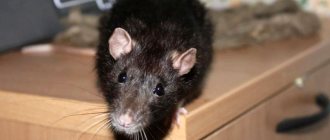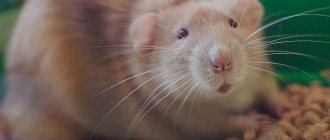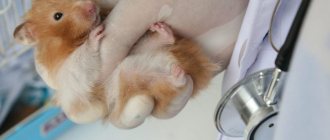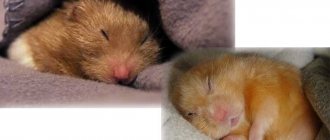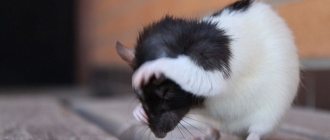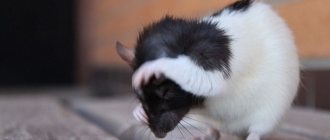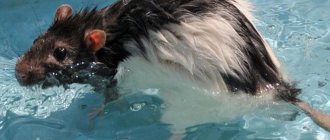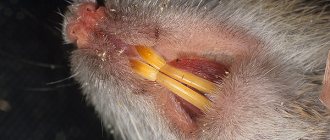Any animal that a person gets at home requires adequate care and maintenance. Without the right attitude towards your pet, he will definitely get sick. Therefore, you need to ask yourself the question: are you ready to take responsibility for the animal? Before buying a specific animal, you need to at least minimally study the rules of its maintenance, nutrition and possible diseases.
One of the most common pets is the decorative rat. She is not as aggressive as her street counterparts and does not tolerate infections (unless, of course, she was initially sick). Most rodents are affectionate and respond well to human interaction. However, no owner is insured against possible pet diseases. Therefore, you need to know what diseases rats suffer from, how to treat them, and what preventive measures to take to protect the animal.
Main causes of heavy breathing
It is impossible to recognize the true cause of wheezing and heavy breathing in a decorative rat. For diagnosis, you need to contact a veterinarian. Typically, symptoms from the respiratory system indicate the presence of respiratory, cardiac or cancer diseases.
Neoplasms
Rats are genetically prone to developing tumor diseases. Neoplasms localized in the throat, lungs or abdominal cavity can strongly compress the organs of the respiratory system, preventing normal air exchange. In this case, the rat exhibits the following pathological symptoms:
- rapid breathing with snoring;
- constant tilting of the head;
- weight loss;
- lethargy, decreased motor activity;
- loss of appetite.
Large tumors are visible to the naked eye. Small seals can be felt with your fingers. The likelihood of developing both benign and malignant tumors increases with the age of the animal. Once a rat reaches 2 years of age, the risk of developing cancer doubles.
If suspicious symptoms appear, you should contact your veterinarian. The doctor will not only detect the presence of a neoplasm, but also determine its nature. This is very important because malignant tumors in small rodents cannot be treated. The owner will be offered to go home with the pet to spend the last days together. Or, in severe cases, they will offer euthanasia.
If the tumor turns out to be benign, the rat will be treated surgically. The tumor will be removed and the wound will be sutured using absorbable sutures. It is worth noting that after the operation the animal will need rest and special care. All necessary recommendations regarding the rehabilitation period will be given by the attending physician.
Mycoplasmosis
Mycoplasmosis is a fairly common disease of the respiratory system among rodents. The carrier of the disease is the bacterium Mycoplasma. Infection of a healthy animal from a sick one usually occurs through airborne droplets, as well as under inappropriate housing conditions. Unfavorable factors contributing to the development of pathology in decorative rats are:
- low immunity;
- ARVI;
- allergic reactions;
- psycho-emotional stress;
- prolonged hypothermia.
In some cases, the disease in decorative rats is asymptomatic. With a mild form of mycoplasmosis, the following signs appear:
- dyspnea;
- grunting while breathing;
- nervousness;
- mood swings;
- refusal to eat;
- appearance of porphyrin.
If the listed symptoms are left unattended, mycoplasmosis will develop into a severe form, which is characterized by more painful symptoms:
- itchy skin, constant scratching;
- wheezing and whistling while breathing;
- dulling of fur;
- impaired coordination of movements;
- constant tilting of the head to one side is a symptom of developed otitis media;
- hunched over.
The listed symptoms indicate the need for an urgent visit to the veterinary clinic. Untreated mycoplasmosis often develops into pneumonia. If this happens, it is unlikely that you will be able to save your pet. After examination and diagnosis, the doctor will prescribe appropriate treatment:
- Since mycoplasmosis is an infectious disease, the rat will be prescribed antibiotics. Azithromycin, Ofloxacin, and Gentamicin are considered the most effective for treating pathology.
- To remove mucus from the lungs, the pet will be prescribed Lazolvan, Ambrohexal, Bromhexine. For ease of administration, it is better to choose medications in liquid form.
- To relieve bronchospasm, your veterinarian will prescribe bronchodilator medications. The most effective for mycoplasmosis are Ephedrine, Salbutamol, Terbutaline.
- In severe cases of the disease, intravenous corticosteroids may be prescribed. Prednisolone is most often prescribed to treat rats.
Also, during treatment you will have to make changes to the rodent's menu. It is recommended to include more fermented milk products in your pet's daily diet. Firstly, they are nutritious and easy to digest. Secondly, they populate the pet’s intestines with beneficial microflora, which is simply necessary when taking antibiotics.
To reduce the load on the respiratory system during the rehabilitation period, you will need to follow the following rules:
- in the morning and evening, ventilate the room in which the cage with the sick rat is located;
- maintain indoor humidity at 55-65%;
- protect your pet from drafts;
- prevent the penetration of pungent odors into the room (for example, household chemicals, paint, cigarette smoke).
Since mycoplasmosis is infectious in nature, the sick pet will have to be placed in a separate cage from other rats until complete recovery.
Diseases of the cardiovascular system
With the development of heart disease, the rat experiences shortness of breath, characteristic of heart disease. Depending on the severity of the pathology, rapid breathing may be accompanied by sobbing, whistling, and the animal constantly opens its mouth, trying to catch air.
Respiratory failure in diseases of the cardiovascular system is explained by poor blood supply to all tissues and organs. As a result, the fluffy experiences oxygen starvation and tries to make up for the oxygen deficiency by breathing more intensely.
Heart disease in decorative rats develops under the influence of such unfavorable factors as obesity, sedentary lifestyle, hormonal changes, old age, poor environment, and frequent stress. The presence of pathology of the cardiovascular system in a rodent can be guessed by the appearance of characteristic symptoms:
- constant coughing;
- uneven breathing with wheezing;
- cyanosis of the skin;
- fast fatiguability;
- constant desire to sleep, decreased physical activity;
- cold paws;
- bloating in the abdominal area;
- swelling.
There is no universal treatment regimen for the presence of heart disease in decorative rats. In each individual case, the veterinarian selects an individual therapeutic course. It is usually based on drugs whose action is aimed at strengthening the heart muscle. For example, Riboxin, Panangin, Asparkam, Prednisolone, Cordiamin.
You will also need to take care of the animal's safety. To prevent a weakened rat from falling and getting injured, it is necessary to dismantle all ladders, shelves, and hanging hammocks in the cage. Feeders and drinking bowls with clean water should be located in such a way that a sick animal does not have to reach for them.
Diagnostics
Although definitive diagnosis is difficult, mycoplasmosis is very common and well recognized in rats. The presumptive diagnosis of mycoplasmosis is usually based on characteristic clinical signs.
- Survey radiographs
X-rays can usually be performed without sedating or anesthetizing the pet rat. Get two views, as with other mammals. Assessing lung lesions can help determine prognosis and monitor response to therapy.
- Bacterial culture and sensitivity testing
Collecting in-depth diagnostic samples from pet rats may not be possible, although some clinicians will submit respiratory secretions for analysis. Mycoplasma spp. difficult to isolate because it cannot be grown by conventional cultivation methods.
- Blood analysis
A general blood test will help determine the degree of the inflammatory process.
Other causes of difficulty breathing
In addition to the listed main causes of heavy breathing with whistling, coughing and grunting, the following pathological conditions can lead to the appearance of similar symptoms:
- Low humidity in a room with a cage . The optimal figure is considered to be 50-60%. At lower values, the animal’s mucous membranes dry out and a lot of mucus forms in the nasal passages. The result is difficulty breathing with a characteristic gurgling sound.
- Deviation of the nasal septum . Such anatomical features are characteristic not only of humans, but also of animals. In this case, there is no way to get rid of noisy breathing. The main thing is to take the rat to a veterinary clinic and make sure that the problem is the curvature.
- If the condition deteriorates sharply, the animal suffocates and struggles in a fit, most likely the pet simply choked . In such a situation, you need to take the fluffy in your hands, fix the head (so that the neck does not dangle) and trot intensively. The stuck piece of food should pop out.
- ARVI . An animal with a cold usually coughs and sneezes intensely and breathes heavily. A rat can catch ARVI from a banal draft or hypothermia. Antibiotics and mucolytic drugs will help your pet against colds.
- Allergic reactions . When an animal has an allergy, it’s not just breathing problems that arise. Fluffy begins to itch intensely, the eyelids swell, and a small rash appears on the skin. Most often, rats are allergic to low-quality litter or food (citrus, red pepper, sweets). Therefore, to alleviate the animal’s condition, the first step is to eliminate the allergen. After which - give a couple of drops of an antihistamine - Fenistil, Dezal, Zodak.
Sometimes allergic reactions can develop into life-threatening conditions for the animal - Quincke's edema and anaphylactic shock. At the same time, the pet begins to fall, suffocate, greedily swallowing air through its mouth. As an emergency, you will need to inject your fluffy with Prednisolone in combination with Suprastin.
How does a healthy rat breathe?
If your rat is healthy, it will have a normal breathing rate and temperature. Rodent owners should carry a thermometer to check their pet's temperature. Ask your veterinarian to teach you how to take your rat's rectal temperature to get the most accurate reading. The normal temperature for a rat is 38.5 – 39.5C.
How to check a rat's breathing rate? Count the number of breaths the animal takes in 15 seconds, then multiply that number by four. The best way to count a rat's breathing is to watch its chest rise, or to hold your hand to its nose and count each time it exhales. The normal breathing rate should be 30-60 breaths per minute.
Prevention
Breathing problems in a decorative rat can lead to serious complications, including the death of the animal. Therefore, it is better to take care of your pet’s health in advance and prevent the development of pathologies of the respiratory system. Preventive measures include:
- Proper nutrition . A balanced diet will strengthen the furry's immune system, prevent excess weight gain and the deposition of cholesterol plaques in the blood vessels. In addition to ready-made food, the pet’s menu must include fresh fruits, berries, vegetables, dairy products, lean meat, nuts, fish, and seafood. At the same time, it will be necessary to exclude sweet, salty, fried, spicy, smoked foods and baked goods from the rat’s diet.
- Maintaining hygienic conditions . To avoid the development of infectious diseases, you will need to always keep your pet's cage clean - clean it every week. And once a month - completely disinfect the cage and its contents. The filler needs to be changed as needed. But no less than once every 2-3 days.
- Protecting your fluffy from colds . Rats are very sensitive to changes in environmental conditions; they can get sick from the slightest breeze. Particular attention should be paid to drying the animal's fur after bathing.
- Protecting your pet from nervous tension . Clashes with other pets, noisy parties, long travels - all of the above can become a huge stress for a rat. And many diseases, especially oncology, develop against the background of an unstable psycho-emotional state.
- Eliminating potential allergens from a rodent's life . For rats, these can be grapes, citrus fruits, dried apricots, sausages, yogurt, strawberries, and pine filler.
If the rat is breathing heavily, choking, wheezing, grunting, or opening its mouth, do not immediately panic. It is necessary to find out the causes as early as possible and select appropriate treatment. Naturally, with the help of a veterinarian. Under the supervision of a specialist, it will be possible to restore your pet’s well-being quickly and without problems.
Rat care
If the pet rat's appetite continues to be good and clinical signs are relatively mild or moderate, the treatment plan should include:
- Changes in content as needed.
- Provide low-dust litter, such as recycled paper products.
- Make sure the cage is well ventilated and cleaned frequently. Clean the cages and fill the cage with soapy water, then soak in a mixture of diluted bleach (one part standard bleach to 20 parts water).
- Gradually transition to good quality rat pellets or rodent blocks.
- Maintain the room temperature between 18 and 27ºC. On average 22ºC and humidity from 40 to 70%.
- Also provide as much space as possible for each rat.
- Combined antibacterial therapy
- Give the antibiotic Doxycycline 5 mg/kg orally every 12 hours.
- Many veterinarians have successfully used Doxycycline in combination with Enrofloxacin 5-10 mg/kg orally every 12 hours.
- Closely monitor your rat's breathing, behavior, appetite, and body weight.
Possible complications and consequences
Any neuralgia, in particular intercostal neuralgia, that does not respond to treatment, may be a sign of a serious illness. Most of the complications that arise with thoracalgia are precisely a manifestation of the underlying pathology, which worsens against the background of constant pain.
Chest neuralgia itself, with a long-term severe course, can provoke the development of a hypertensive crisis or an attack of angina (less often, myocardial infarction). Severe, constant pain affects a person’s physical and mental state in different ways. Often severe symptoms of intercostal neuralgia on the left or right significantly complicate the patient’s life. He sleeps poorly, is nervous, cannot move normally and do his usual work.
Pain in the intercostal spaces does not allow the patient to perform full breathing movements, which leads to a decrease in oxygen supply to the body and the development of hypoxia. Sometimes neuralgia is accompanied by such debilitating pain that it contributes to emotional exhaustion, and this is a serious complication, since this condition causes depression.
How to distinguish intercostal neuralgia from heart disease?
If neuralgia has acute symptoms in the thoracic region on the left side, differential diagnosis with heart disease must be carried out. You should not look for the cause of the pain syndrome on your own. Thoracalgia on the left side should always be a reason to consult a doctor.
Heart pain and symptoms of intercostal neuralgia on the left have distinctive features:
| Intercostal acute neuralgia on the left: typical symptoms | Cardiovascular diseases: characteristic manifestations |
| The pain intensifies with forced breathing, coughing, sneezing, laughing, physical exertion and movement, but does not change with fast walking and excitement. | The pain does not change its intensity with a deep breath or muscle tension, but intensifies with cardio exercise (fast walking, running, climbing stairs). |
| Chest neuralgia is not relieved by taking nitroglycerin | With angina pectoris, the pain attack goes away within 3-5 minutes after using nitroglycerin. With myocardial infarction, severe pain cannot be relieved with medications. In this case, you should immediately call an ambulance. |
| Normal pulse and blood pressure are determined | Changes in heart rate and blood pressure |
| Pain increases with palpation of the ribs and spaces between them | The intensity of pain does not change when palpating the intercostal spaces |
| Painful symptoms on the left “go” along the nerve or are encircling in nature | Pain is localized behind the sternum or in the projection of the heart |
Symptoms of intercostal neuralgia on the left and right should also be differentiated from other diseases (pleurisy, pneumonia, thoracic aortic aneurysm, pericarditis, acute pancreatitis and others). If there is severe pain in the chest, only a doctor can determine exactly what it is - neuralgia or another pathology.
Is osteopathy effective for intercostal neuralgia?
The causes of neuralgia in the rib area can be different. However, in many cases, a pinched nerve is caused by the consequences of various injuries a person has received in the past. The capabilities of fine diagnostics using hands make it possible to identify and eliminate these disorders, which leads to the elimination of compression of the nerve and the restoration of its normal blood supply. As a result, inflammation and its integral companion – pain – go away. Osteopathy shows high effectiveness in the treatment of both unilateral and bilateral intercostal neuralgia.
What is intercostal neuralgia?
Neuralgia of the intercostal nerves is pain of a different nature that occurs due to various etiological factors. It is more often observed in adult men and women over 30-35 years of age. Symptoms of neuralgia may appear suddenly on one or both sides of the chest, along one or more intercostal nerves. The disease has an ICD code - M.79.2.
To understand what intercostal neuralgia is, you should understand the anatomical features of the thoracic nerves. There are 12 pairs in total. Each intercostal nerve contains motor, sensory and sympathetic fibers. It originates from the anterior roots of the spinal cord of the thoracic spine, passes along the lower edge of each rib, reaching the sternum. The parietal pleura covers the nerve fibers on top.
Thoracic nerves transmit impulses to the skin, the musculo-ligamentous apparatus of the chest and the anterior wall of the abdomen, partly the pleura and peritoneum, and the mammary glands. Sensitive fibers of neighboring nerve trunks actively interact with each other, creating cross innervation.
